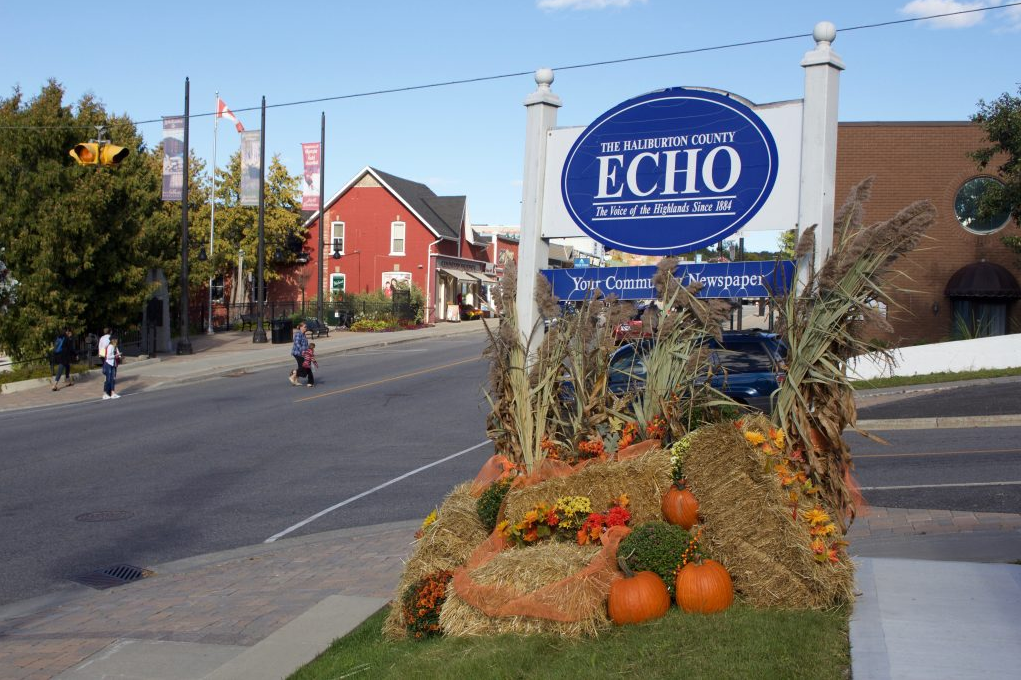This is cottage country—Canadian Shield, white pine, and wildflowers lining the road. Around every bend, atop every hill, a lake seems to sparkle in the distance. The Haliburton Echo—”proudly serving the Highlands since 1884″—sits along Haliburton’s main thoroughfare, Highland Street, with a view of Head Lake. A plaque commemorates the building’s heritage status: Laking House, circa 1917.
The Echo serves all of Haliburton County, a 4,076-square-kilometre area bordering Algonquin Park to the north and the City of Kawartha Lakes to the south. The county’s 18,062 year-round residents can get their news from three local papers and two radio stations. The four full-time Echo reporters almost always meet their sources in person. They visit classrooms, ball fields, cottages. They attend the Wilberforce Carnival, the Festival of the August Moon. They are invited to fly Citabria airplanes on Young Eagles Day, wobble on paddle boards at the Home and Cottage Show. They meet with three elderly women who have spent a year making a quilt for a soon-to-arrive Syrian refugee family. The women call the quilt’s colour scheme—rose, lavender, pale yellow—”Haliburton Happy.”
But it isn’t always so “Haliburton Happy” around here. The county is one of the poorest communities per capita in Ontario. Nearly a quarter of its children live in poverty. The Echo documents the challenges of its little corner of rural Canada—reporting on homelessness, inefficient emergency response, service cutbacks and losses. Coverage of these issues creates near-instant results. Anti-gay vandalism at the entrance of Prettypaws Pet Boutique and Spa elicits hundreds of messages of support for the owner and a county-wide campaign where businesses display rainbow-coloured stickers that say Safe Zone—I am an Ally. When the town of Wilberforce’s only bank, Scotiabank, says it’s closing and tells residents to drive 30 minutes to Bancroft instead, the Highlands East reeve threatens to withdraw the township’s entire $10-million account.
Whether it’s a township’s millions or a loonie auction’s hundreds, local news covers the full spectrum of civic engagement. In this and many other ways, rural and small-town media outlets play a different role than their urban counterparts, says Joe Banks, a professor and journalism program coordinator at Algonquin College.
“You can’t really compare apples to oranges,” says Banks, who began his career at the Echo in the 1970s. “It’s a different set of priorities. You are an everything person in a small rural paper. You do it all.” You cheerlead, you inform, you investigate.
A study conducted by the New Rural Economy—a national initiative conducting research in 32 communities across Canada since 1996—calls local media’s relationship to the community “critical,” both in creating links within the community and building bridges beyond. Local news outlets can be directly connected to a community’s capacity-building—the ability of a community to transform assets and liabilities into desired outcomes, the report says. In other words, a healthy local news ecosystem creates a healthier community.
Since his stint at the Echo, Banks has watched Haliburton transform from what he calls “a tired little town out of the 50s” to a “perked up” civically engaged community hosting farmer’s markets, an arts and design college, theatre groups, even an opera school. He attributes this transformation to “an extension of a vibrant media scene.”
With a population that has grown by more than 1,000 year-round residents since 2011, more and more people are calling Haliburton county home. But population growth is an exception to the rule of rural Canada.
…
When the Haliburton Echo first opened its doors in 1884, nine out of 10 Canadians lived in rural Canada. Now, only one in five live in what Statistics Canada defines as rural or small town communities—towns and municipalities outside commuting zones of centres with populations of 10,000 or more. Along with a declining population, numerous studies have found rural Canada suffers from high unemployment rates, low immigration numbers, and lack of infrastructure. Rural Canadians also experience a greater number of health risks, including shorter life expectancies, and higher rates of suicide, accident, and disability.
Continue reading this story on the Local Journalism Conference webpage.
Angela Long is a freelance journalist based in Toronto currently working on a book about rural journalism in Canada.

